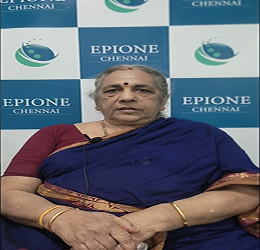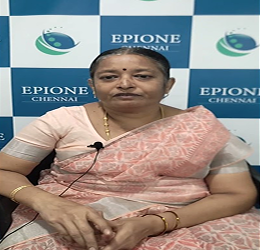9962 413 413
Book Appointment
I finally got relief from my back pain thanks to Epione
Mrs. Aswathi Subramanyan
Back Pain Treatment
My sister suffered from Knee pain for 5 years but finally found pain relief at Epione
Mrs. Chandra
Foot and Ankle Pain Treatment
Dr Chetana Chetan help me from knee pain due to arthritis
Mrs. Kavitha
Foot and Ankle Pain Treatment
What is Neck Pain?
Neck pain is the pain arising in the neck , between the shoulders & up the back of the head into the hairline. Neck pain can be quite disturbing interfering with day-to-day life, including your ability to sleep, feel productive, and enjoy your family time. And it affects more than just your physical body. Research suggests that chronic pain can have an impact on a person’s mental health; up to 85 percent of patients with chronic pain are affected by severe depression. Poor posture can strain neck muscles, whether it’s leaning over the computer or sleeping in an awkward position. Many people suffer from neck discomfort regularly. Neck pain can sometimes also be caused by a fall, contact sports, or whiplash (head jerking).
Neck pain, for the most part, isn’t a major problem and can be resolved in a matter of days. On the other hand, it can sometimes signify a serious injury or sickness that necessitates medical attention under the best doctor for neck pain in Chennai.
What Causes Neck Pain?
Because the neck is flexible and bears the head’s weight, it is susceptible to injuries and disorders that cause pain and limit movement. The following are some of the reasons for neck pain:
- Muscle strain: Muscle strains are frequently caused due to lying in an awkward position for a long period. Neck muscles can be strained by even simple activities such as reading in bed or grinding the teeth.
- Disc degenerative disease: Like the rest of the body’s joints, the neck joints deteriorate with age. The cushions (cartilage) between the bones (vertebrae) degrade due to osteoarthritis.
- Nerve compression: The nerves in the neck might be compressed by herniated discs or bone spurs in the vertebrae.
- Injuries: Injuries due to jerking the head can put a strain on the neck’s soft tissues, often requiring care from a neck pain doctor specialist.
- Diseases: Neck pain can be caused by rheumatoid arthritis, meningitis, or cancer.
What are the Types of neck pain
There are 3 types of neck pain
- Neuropathic neck Pain –
Arising from the nerves or nerve roots in the cervical spine, neuropathic neck pain could result from conditions such as a herniated disc that compresses a nearby nerve or nerve root . - Mechanical neck pain –
The spine and its supporting structures (e.g., muscles, ligaments, bones, or cartilage) are the cause of pain . Typically, mechanical pain is caused by poor posture, neck strain caused by work or sporting/physical activities, and even stress. - Central neuropathic pain –
Most commonly it occurs as a result of a stroke, spinal cord injury, or multiple sclerosis. It may also be a result of injury to the central nervous system, caused by traumatic injury to the brain/spinal cord or infection (e.g., abscess, encephalitis, myelitis) or tumour that needs thorough need and support from the neck pain doctor in Chennai.
What are the Symptoms of Neck Pain?
You may need a neck pain specialist in Chennai if following are some of the symptoms:
- Muscle spasms and stiffness in the back of the head or a “muscle knot” in the neck. This may spread to your shoulders, upper back and arms.
- Limited capacity to move the head
- Moving, twisting, or extending the cervical spine from side to side or up and down might aggravate neck pain.
- Headache, specially complained in the occipital region (back of the scalp) is very common but can also extend up to the top of the head, causing “tension” headaches from muscle tightness.
- If the neck pain is caused by nerve compression, it may result in the following symptoms:
- Weakness in the shoulder, arm or hand – one or both the sides
- A feeling of numbness or “pins and needles” in arm, fingers or hand
- Sharp, burning type of pain near the pinched nerve that radiates downwards
Some conditions, like coronary artery disease (angina) or even lung tumors may mimic these conditions.
How is Neck Pain Diagnosed?
The neck pain specialist doctor Chennai may conduct imaging studies to gain a better clarity of the neck pain.
- X-rays: X-rays can indicate places in the neck where bone spurs or other degenerative changes may be compressing the nerves or spinal cord. X-ray will not provide details about soft tissue like muscles, ligaments or intervertebral discs.
- CT scan
- MRI: MRI creates detailed images of bones , discs and other soft tissues using radio waves and a strong magnetic field.
- Electromyography (EMG) & Nerve Conduction Studies (NCS) are advised when a particular muscle or nerve is thought to be the culprit of pain.
The most important aspect of the neck pain treatment or the back pain treatment in Chennai is to try to identify the underlying pain generator, as it guides the treatment.
What is the Treatment for Neck Pain?
If you are having neck pain (2+ weeks), it is important to seek medical attention for further evaluation and treatment. Treatments for neck pain vary, depending on the cause and duration of the neck pain you are experiencing. Many neck pain patients find relief in using one or a combination of these therapies. The most common treatments include
Medications
Over-the-counter pain killers can be prescribed during mild to moderate neck pain.
Nonsurgical Interventional pain management procedures
Interventional treatments for neck pain management can be a faster and more effective source of pain relief. These procedures are beneficial when conservative medical care and drugs have failed to relieve severe pain.
Depending on the cause of neck pain, the following non-surgical treatments can be performed:
- Spinal cord stimulations– When the inflammation in and around the afflicted nerves is too severe for an epidural injection, spinal cord stimulation (SCS) is an excellent and successful therapy option for pain relief without surgery. An electrical pulse is given directly to the spine in SCS, restricting the passage of certain neuron fibres to the brain and, as a result, the brain’s ability to experience the previously perceived pain.
- Radiofrequency Ablation (RFA) – Radio waves are sent through a nerve, stunning it and preventing it from transmitting pain.
- Chiropractic Care: It focuses on spinal alignment to relieve extreme pressure on nerves, improve mobility, and reduce chronic back and neck pain. It’s a drug-free, hands-on method that restores natural body function.
- Massage Therapy: Relieves muscle tension, boosts circulation and promotes relaxation. Ideal for managing stress-related pain, fibromyalgia and sports injuries.
At Epione, we offer a holistic approach to pain relief through nonsurgical interventional procedures that are both effective and gentle on your body.
Why Choose Epione Chennai for Neck Pain Treatment?
If neck pain has become a daily struggle, it’s time to turn to the experts at Epione Chennai where world-class care meets heartfelt support. We don’t just offer treatment; we offer relief that lasts.
As the most trusted and reputed pain management clinic in Chennai, at Epione, you will find our team of experienced doctors and specialists who truly understand the complexities of neck pain. With a commitment to expert care and advanced treatments, we use the most advanced and latest technology and techniques to treat the cause of your discomfort and offer the most effective treatments.
What makes us different? Our focus on non-surgical solutions. Be it our knee specialist or neck pain doctor, we believe in treating pain without invasive or surgical procedures whenever possible. From precision-guided injections to cutting-edge therapies, our approach is modern, safe and highly result-oriented.
But we don’t stop at technology. We know every patient is unique, which is why we design personalised treatment plans that suit your lifestyle, needs and recovery pace. Plus, our warm, approachable team is with you at every step, offering compassionate support and clear guidance.
At Epione Chennai, we help you to gain flexibility to move freely and sleep better with our real and long-lasting relief from neck pain. Why wait in pain when the expert cervical spondylosis treatment in Chennai is just around the corner? Choose Epione; Choose comfort because your neck deserves nothing less than the best.
Frequently Asked Questions
How do I know if my lower back pain requires medical attention?
If your pain is severe, lasts longer than two weeks, radiates down the legs or affects daily activities, it’s time to consult a specialist for proper evaluation and care.
Can stress and poor posture contribute to neck pain?
Yes, both stress and poor posture can strain neck muscles, leading to stiffness and discomfort. Managing stress and improving posture are essential steps toward long-term neck pain relief.
Is neck pain more common in certain age groups?
Neck pain can affect all ages but is more common in adults over 30 or 40 years due to age-related wear, sedentary habits and prolonged screen use. Early assistance from a neck pain specialist doctor in Chennai helps prevent worsening.
What lifestyle factors can worsen neck pain?
Poor posture, prolonged screen time, lack of movement, stress and incorrect sleeping positions can all aggravate neck pain. Making small daily adjustments can significantly ease your discomfort.
How long does it typically take to recover from neck pain?
Recovery varies based on severity. Mild cases improve within days; chronic or severe pain may need weeks of therapy. As a trusted neck pain specialist in Chennai at Epione, we create personalised plans to support faster recovery.
Is it normal to experience headaches along with neck pain?
Yes, tension in neck muscles can trigger cervicogenic headaches. If headaches accompany your neck pain, consult a specialist neck pain doctor in Chennai for accurate diagnosis and targeted treatment at Epione.
Which therapy is best for neck pain?
Effective therapies include physiotherapy and radiofrequency ablation. At Epione, we customise treatments to your condition for safe, long-lasting relief without surgery.
What doctor should I consult for neck pain?
Consult a neck pain specialist in Chennai or spine expert. At Epione, our multidisciplinary team provides advanced, non-surgical care tailored to your neck condition and lifestyle needs.
What is the best treatment for neck problems?
The best treatment depends on the cause. Options include physiotherapy, medications, plasma injections or regenerative therapies – all available at Epione through expert-guided, non-invasive care plans.
What is the permanent solution for neck pain?
A permanently effective solution involves accurate diagnosis, lifestyle changes and the right therapy. At Epione, we focus on long-term relief through advanced and personalised treatments that target the root cause.




